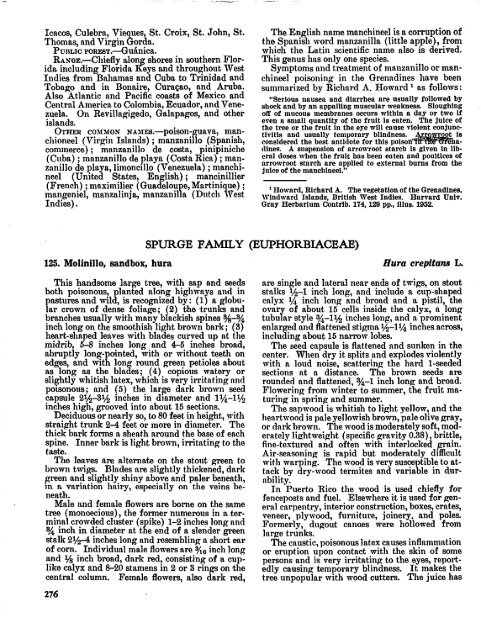Common Trees of Puerto Rico and the Virgin Islands
Common Trees of Puerto Rico and the Virgin Islands
Common Trees of Puerto Rico and the Virgin Islands
Create successful ePaper yourself
Turn your PDF publications into a flip-book with our unique Google optimized e-Paper software.
Icacoq Culebra, Vie ues, St. Croix, St. John, St.<br />
Thomas, <strong>and</strong> <strong>Virgin</strong> 8 orda.<br />
PU~LIC ~~o~m~.--Guinica.<br />
RAXGE.-Chiefly alon shores in sou<strong>the</strong>rn Floridn<br />
including Florida I e eys <strong>and</strong> throughout West<br />
Indies from Bahamas <strong>and</strong> Cuba to Trinidad <strong>and</strong><br />
Tobago <strong>and</strong> in Bonah, Curwao, <strong>and</strong> Aruba.<br />
Also Atlantic nnd Pacific coasts <strong>of</strong> Mexico <strong>and</strong><br />
Central America to Colombia, Ecuador, <strong>and</strong> Venezuela.<br />
On Revillagigedo, Galapagos, <strong>and</strong> o<strong>the</strong>r<br />
isl<strong>and</strong>s.<br />
OTHF~~ CO~LMON ~~~m.-poison-guava, manchioneel<br />
(<strong>Virgin</strong> Isl<strong>and</strong>s) ; manzanillo (Spanish,<br />
commerce) ; mnnzanillo de costa, pinipiniche<br />
(French) ; maximilier<br />
maqeniel,<br />
Indies).<br />
SPURGE FAMILY (EUPHORBIACEAE)<br />
The English name manchineel is a corruption <strong>of</strong><br />
<strong>the</strong> Spanish word manznnilla (little apple), from<br />
which <strong>the</strong> Latin scientific name also is derived.<br />
This genus has only one species.<br />
Symptoms <strong>and</strong> treatment <strong>of</strong> manzanillo or man-<br />
chineel poisoning in <strong>the</strong> Grenadines have been<br />
summarized by Richard A. Howard1 as follows:<br />
"Serious nausea <strong>and</strong> dlarrhea are usually followed by<br />
shock <strong>and</strong> by an appalling muscular weakness. Sloughing<br />
on <strong>of</strong> mucous membranes occurs within a day or two if<br />
even a small quantity <strong>of</strong> <strong>the</strong> fruit is eaten. The juice <strong>of</strong><br />
<strong>the</strong> tree or <strong>the</strong> fruit in <strong>the</strong> eye will cause violent conjunc-<br />
tivitis <strong>and</strong> usually temporary blindness.<br />
considered <strong>the</strong> best antidote for thls poison<br />
clines. A suspension <strong>of</strong> arrowroot starch is given in lib-<br />
eral doses when <strong>the</strong> fruit has been eaten <strong>and</strong> poultices <strong>of</strong><br />
arrowroot starch are applied to external burns from <strong>the</strong><br />
juice <strong>of</strong> <strong>the</strong> manchineel."<br />
Howard, Richard A. The vegetation <strong>of</strong> <strong>the</strong> Grenadines,<br />
I\'indward Isl<strong>and</strong>s, British West Indies. Harvard Univ.<br />
Gray Herbarlum Contrib. 174, 129 pp., illus. 1052.<br />
125. MoIinillo, s<strong>and</strong>box, hura Hura crepitans L.<br />
This h<strong>and</strong>some large tree, with sap <strong>and</strong> seeds are single <strong>and</strong> lateral near ends <strong>of</strong> twigs, on stout<br />
both poisonous, planted along highways <strong>and</strong> in stalks 1/2-1 inch long, <strong>and</strong> include a cup-shaped<br />
pastures <strong>and</strong> wild, is recognized by: (1) a globu- cnlyx 1/5 inch long <strong>and</strong> broad <strong>and</strong> a pistil, <strong>the</strong><br />
lar crown <strong>of</strong> dense foliage; (2) <strong>the</strong> trunks <strong>and</strong> <strong>of</strong> about 15 cells inside <strong>the</strong> calyx, n long<br />
bmnches usually with many blackish spines tubu Ova?' nr style sh-llh inches long, <strong>and</strong> a prominent<br />
inch long on <strong>the</strong> smoothish light brown bark; (3) enlarged nnd flattened stigma 1/2-1% inches across,<br />
hmrt-shaped lenves with blades curved up at <strong>the</strong> including about 15 narrow lobes.<br />
midrib, 5-8 inches long <strong>and</strong> 4-5 inches broad, The seed capsule is flattened <strong>and</strong> sunken in <strong>the</strong><br />
abruptly long-pointed, with or without teeth on center. When dry it splits <strong>and</strong> explodes violently<br />
edges, <strong>and</strong> with lonm round pen petioles about with a loud noise, scattering <strong>the</strong> hard 1-seeded<br />
ns long ns <strong>the</strong> blaxes; (4) copious watery or sections at a distance. The brown seeds are<br />
sli~htly whitish latex, which is very irritating nnd rounded <strong>and</strong> flattened, %-I inch long <strong>and</strong> broad.<br />
poisonous; nnd (5) <strong>the</strong> lnrp dnrk brown seed Flowering from winter to summer, <strong>the</strong> fruit macapsule<br />
2%-3% inches in dlameter <strong>and</strong> lj/q-1?L2 turing in spring <strong>and</strong> summer.<br />
inches high, grooved into about 15 sections.<br />
The snpmood is whitish to light yellow, <strong>and</strong> <strong>the</strong><br />
Deciduous or nearly so, to 80 feet in height, with henrtwood is pale yellowish brown, pale olive gray,<br />
straight trunk 2-4 feet or more in diameter. The or dnrk brown. The wood is moderately s<strong>of</strong>t, modthick<br />
bark forms a sheath around <strong>the</strong> base <strong>of</strong> each erately lightweight (specific gravity 0.38), britt!e,<br />
spine. Inner bark is light brown, irritating to <strong>the</strong> fine-textured <strong>and</strong> <strong>of</strong>ten with interlocked gram.<br />
taste.<br />
Air-seasoning is rapid but moderately difficult<br />
The leaves are alternate on <strong>the</strong> stout p n to with warping. The wood is very susce tible to atbrown<br />
twigs. Blades nre slightly thickened, dnrk tack by dry-wood termites nnd varia 6 le in durgreen<br />
<strong>and</strong> slightly shiny above <strong>and</strong> paler beneath, ability.<br />
In n variation hairy, especially on <strong>the</strong> veins be- In <strong>Puerto</strong> <strong>Rico</strong> <strong>the</strong> wood is used chiefly for<br />
neath.<br />
fenceposts <strong>and</strong> fuel. Elsewhere it is used for gen-<br />
Male <strong>and</strong> femnle flowers are borne on <strong>the</strong> snme eral carpentry, interior construction, boxes, crates,<br />
tree (monoecious), <strong>the</strong> former numerous in n ter- veneer, ply\rood, furniture, joinery. <strong>and</strong> poles.<br />
minal crowded cluster (s ike) 1-2 inches long <strong>and</strong> Formerly, dugout canoes were hollowed from<br />
inch in diameter at t k' e end <strong>of</strong> a slender green large trunks.<br />
stalk 2v2-4 inches long <strong>and</strong> resembling a short enr The caustic, poisonous latex causes inflammation<br />
<strong>of</strong> corn. Individual male flowers are s/lo inch long or eruption upon contact yith <strong>the</strong> skin <strong>of</strong> some<br />
<strong>and</strong> 4/8 inch broad, dark red, consisting <strong>of</strong> a cup- persons <strong>and</strong> is very irritatmg to <strong>the</strong> eyes, reportlike<br />
calyx <strong>and</strong> 8-20 stnmens in 2 or 3 rings on $he edly causing temporary blindness. It mnkes <strong>the</strong><br />
central column. Female flowers, also dark red, tree unpopular with wood cutters. The juice has<br />
276

















